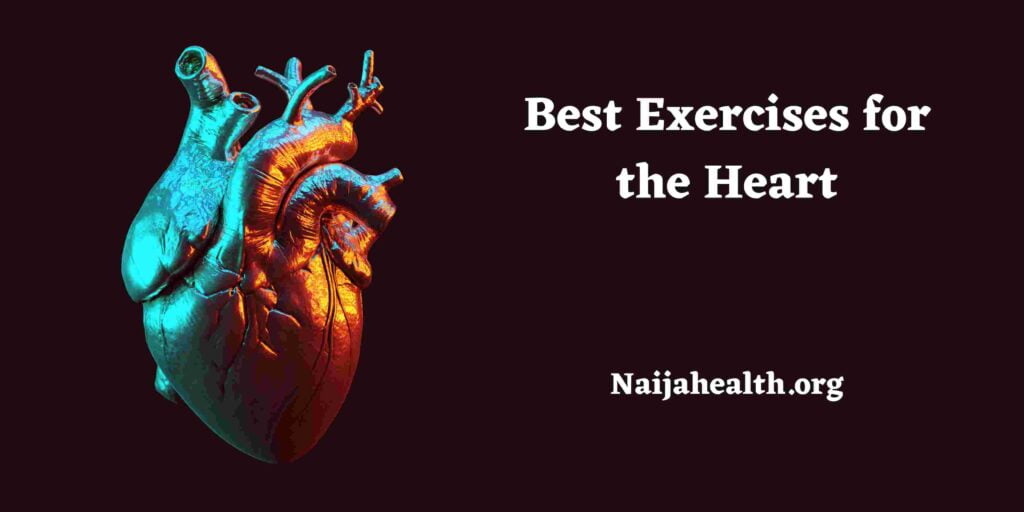
Best Exercises for the Heart
Heart health is an important aspect of overall health and plays an important role in maintaining a healthy lifestyle. The heart is an important organ responsible for pumping oxygen-rich blood throughout the body, delivering nutrients and oxygen to various tissues and organs. Taking care of your heart with regular exercise is key to reducing your risk of cardiovascular disease, improving circulation, and improving overall cardiovascular health.
Benefits of Regular Exercise for Heart Health
Regular exercise has many benefits for heart health.
Here are some of the key benefits of engaging in physical activity:
- Strength of heart
Exercise strengthens the heart muscle, making it pump blood around the body more efficiently. This enhanced pumping ability reduces pressure on the heart and improves its overall function.
- Reduce your risk of heart disease
Regular physical activity can significantly reduce your risk of developing heart disease. It helps control various risk factors such as high blood pressure, high cholesterol and obesity, which contribute to heart disease.
- Improves Heart Health
Exercise improves cardiovascular health by increasing the body’s ability to use oxygen. This improves endurance, allowing individuals to participate in daily activities with less fatigue and exertion.
- Lower blood pressure
Physical activity helps lower blood pressure, both in people with hypertension and those with normal blood pressure. Regular exercise can lower systolic blood pressure (the top number) by an average of 4-9 mmHg, comparable to some antihypertensive drugs.
- Manage cholesterol levels
Aerobic exercise can increase levels of high-density lipoprotein (HDL) cholesterol, commonly known as “good” cholesterol, and lower levels of low-density lipoprotein (LDL) cholesterol, known as bad cholesterol. This balance is important for maintaining heart health and reducing the risk of heart disease.
- Promotes weight control
Regular exercise, combined with a healthy diet, is an effective way to control weight. Maintaining a healthy weight reduces stress on the heart, reduces the risk of obesity-related heart problems, and helps manage conditions like diabetes and metabolic syndrome.
- Improves blood circulation
Exercise improves blood flow and circulation throughout the body. It widens blood vessels, improves the health of the endothelium (the inner lining of blood vessels) and promotes the efficient delivery of oxygen and nutrients to all tissues and organs.
- Reducing Inflammation
Chronic inflammation is associated with an increased risk of heart disease. Regular physical activity has been shown to reduce markers of inflammation in the body, reducing the risk of cardiovascular problems.
- Improve insulin sensitivity
Exercise improves insulin sensitivity, allowing the body to use glucose more efficiently. Improved insulin sensitivity is beneficial for people with diabetes or those at risk for diabetes, as it helps maintain stable blood sugar levels and reduces the risk of heart disease.
- Improve mental health
Exercise has a positive impact on mental health and general well-being. It helps reduce stress, anxiety, and depressive symptoms, all of which can directly or indirectly affect heart health.
10 best exercises for the heart
Here are 10 exercises believed to be beneficial for heart health, along with instructions on how to do them correctly:
- Brisk walking
- Find a suitable walking route or use a treadmill.
- Keep an upright position, swing your arms naturally and walk quickly.
- Aim to walk briskly for at least 30 minutes most days of the week.
- Running/Jogging
- Start with a light jog or brisk walk.
- Maintain a comfortable pace, focusing on deep breathing.
- Gradually increase speed and distance over time, but listen to your body’s limits.
- Cycling
- Use a stationary bike or ride on the street or trail.
- Adjust the seat height to properly stretch your legs and maintain an upright posture.
- Start with comfortable resistance and gradually increase the intensity or distance.
- Swimming
- Choose a swimming style that you are comfortable with, such as freestyle or breaststroke.
- Practice swimming in the pool or take part in water fitness lessons.
- Set a goal of continuous swimming or water exercise for 30 minutes.
- Jumping rope
- Start with a good quality jump rope and find a clear area.
- Jump with both feet, keeping your knees slightly bent and landing gently.
- Start with short intervals and gradually increase the duration as your physical condition improves.
- High Intensity Interval Training (HIIT)
- Choose any cardio exercise (e.g. running, cycling, jumping rope).
- Alternate between high-intensity episodes (e.g., sprinting) and low-intensity recovery sessions.
- For example, sprint for 30 seconds, then recover with 60 seconds of slower activity. Repeat the cycle for 10-20 minutes.
- Circuit training
- Create a sequence of different exercises that target different muscle groups (e.g. jump ropes, pushups, squats, lunges).
- Do each exercise for a certain amount of time or reps before moving on to the next exercise.
- Set continuous, challenging workout goals that get your heart rate up.
- Aerobic dance
- Take a dance class or watch instructional videos.
- Choose dance styles that involve continuous movement and increase your heart rate.
- Have fun and enjoy the rhythm while maintaining good posture and engaging your whole body.
- Elliptical training
- Use the elliptical machine in the gym or in the comfort of your home.
- Start with comfortable resistance and stay upright while gripping the handle.
- Move your legs and arms in a fluid, controlled motion over an extended period of time.
- Stair climbing
- Find a set of stairs, indoor or outdoor.
- Go up and down the stairs several times, focusing on using your leg muscles and maintaining a steady pace.
- Increase duration or intensity as your fitness level improves.
Safety Precautions and Considerations for Individuals with Heart Conditions
For people with heart disease, it’s important to take some precautions and safety considerations before starting or modifying an exercise program. Here are some principles to keep in mind:
- Consult a healthcare professional
Before starting any exercise program, especially if you already have a known heart condition or have any cardiovascular risk factors, consult your healthcare provider. your health. They can assess your specific situation and provide you with personalized recommendations.
- Health condition
Depending on the severity of your condition, your healthcare provider may order stress tests or other assessments to determine exercise tolerance. and identify any limitations or precautions you should take.
- Start slow and increase gradually
If you’re sedentary or haven’t exercised in a while, start with low-intensity activities and gradually increase the duration and intensity over time. This allows your body to adapt and reduces the risk of overworking.
- Choose low-impact activities
Choose low-impact exercises that put less stress on your joints and cardiovascular system. Examples include walking, swimming, biking, and using an elliptical.
- Heart rate monitor
Use a heart rate monitor to monitor your heart rate during exercise. Your healthcare provider can guide you on a target heart rate range based on your condition. Avoid exercising beyond these specified limits.
- Stay hydrated
Drink water before, during, and after your exercise sessions to stay hydrated and maintain good cardiovascular function.
- Warm up and cool down
Always start your exercise program with a warm-up session to gradually increase your heart rate and relax your muscles. Likewise, end your workout with a cool-down period to gradually lower your heart rate and allow for recovery.
- Listen to your body
Pay attention to any warning signs or symptoms during exercise, such as chest pain, dizziness, severe shortness of breath, or an irregular heartbeat. If you experience any of these symptoms, stop exercising and see your doctor.
- Take medication as directed
If you take medication for heart disease, be sure to take it as prescribed by your healthcare provider. Tell your doctor about your exercise plan to make sure your medications are adjusted if necessary.
- Participate in cardiac rehabilitation
Cardiac rehabilitation programs offer supervised exercise sessions specifically designed for people with heart disease. These programs provide a safe and supervised environment with medical professionals who can guide you in proper exercise.
- Consider modifying the assignment
Depending on your specific heart condition, you may need to modify certain exercises. For example, people with severe heart failure may need to avoid activities that require significant effort. Work with your healthcare provider or a certified exercise professional to determine appropriate modifications.
FAQs
How much exercise do I need for optimal heart health?
The American Heart Association recommends at least 150 minutes of moderate-intensity aerobic exercise or 75 minutes of high-intensity aerobic exercise per week. This can be spread over multiple sessions, each lasting at least 10 minutes.
Can I exercise if I have a heart condition?
In many cases, exercise is beneficial for people with heart disease. However, it is important to consult your healthcare provider before starting or modifying an exercise program. They can provide guidance based on your specific condition and help ensure your safety.
What are the signs that I should stop exercising and see a doctor?
If you experience chest pain, severe shortness of breath, dizziness, irregular heartbeat, or any other worrisome symptoms during exercise, stop exercising and seek immediate medical attention. This could be a sign of a heart-related problem that needs to be evaluated quickly.
Are there specific exercises that I should avoid if I have heart disease?
Certain high-impact or high-intensity activities may not be suitable for people with certain heart conditions. Your healthcare provider can recommend exercises to avoid or modify based on your specific condition.
Is it safe for me to do strength training if I have a heart condition?
In most cases, people with heart problems can safely do strength training. However, it’s important to use correct posture, avoid excessive force, and not hold your breath while lifting. Your healthcare provider or a certified exercise professional can guide you through appropriate strength training exercises.
Can exercise help lower blood pressure and cholesterol levels?
Yes, regular exercise can help lower blood pressure and improve cholesterol levels. It’s important to combine exercise with other lifestyle adjustments, such as a healthy diet, to maximize benefits.
Can I exercise during cardiac rehabilitation?
Yes, Cardiovascular Rehabilitation programs are specifically designed to guide people with heart conditions through safe, supervised exercise sessions. These programs can be very beneficial and are often tailored to your specific needs and abilities
Can I exercise if I have joint pain?
If you have joint problems, low-impact exercises like swimming, cycling, or using an elliptical may be more appropriate and put less stress on your joints. Consult your healthcare provider or physical therapist to determine the best exercises for your joint health.
Conclusion
Regular exercise plays an important role in maintaining a healthy heart. Participating in cardiovascular exercise, such as brisk walking, running, swimming, or cycling, can strengthen your heart, improve heart health, and reduce your risk of heart disease. Other benefits include better blood pressure control, improved cholesterol levels, weight control, improved circulation, reduced inflammation, and improved morale.
However, it’s important to take certain precautions, especially for people with heart disease. Consult with a healthcare professional, obtain a medical license if needed, and follow their recommendations are important steps. Starting slowly, progressing gradually, and listening to your body’s signals during exercise are essential for your safety.



Be the first to comment